Chernobyl Part I
April 28th, 2009 by: cheyenne
[You can click any of the images to see the larger version.]
In June of 2005, Joshua and I spent a month and a half in Ukraine and Russia, during which time we visited Chernobyl. I’m a little late with the write-up. Um, sorry about that.
I have always been fascinated with abandoned places. In Spain we were obsessed with Las Abandonadas—ancient rock houses in deserted villages that were sprinkled all over the country, their former inhabitants having either moved to the city or died. In Mexico, we searched out old towns that had emptied after the mines went bust or the money went elsewhere. In the US there are ghost towns (hanta virus! Gak), or more frequently, abandoned factories or warehouses, like those that used to be near my studio in San Francisco (inhabited only by bums and street kids). The places are mysterious, eerie, and very photogenic. A glimpse of post-apocalyptic, science fiction-style doom I suppose. Your imagination tends to run wild when in such places.
The Grandaddy of all the places we ever sought out was Chernobyl (Chornobyl in Ukrainian), the reactor meltdown site and surrounding 30-kilometer radius of no-man’s-land, the “zone.†The reactor itself was interesting and all but what is most fascinating to me is the history and politics surrounding the disaster, and the so-called “ghost town,†Pripyat along with hundreds of small villages that used to exist inside the perimeter but that no longer do.
Getting to the Chornobyl site, in our experience, was actually pretty easy and took but a quick phone call to check our names against a watchlist of International Abandoned Nuclear Reactor Site Spies (or whatever it was they checked). There are a number of agencies in Kiev that arrange tours and they all compete with each other citing this and that difference—of course the prices vary wildly—and they make it sound like it is actually a very difficult and complicated process to get cleared to visit the zone. In addition, they all implied that they themselves did the tours. In the end however, they are all selling you the same thing because all tours within the zone are actually handled from within by a single state agency, Chernobyl InterInform. CII has one set price for everything and in our experience, they were efficient and expedient about processing requests. They pick you up wherever are, take you into the zone, provide a guide, give you a tour, feed you an amazing lunch, and drive you back home at the end of the day. So basically you can skip the Kiev agencies and arrange a visit directly through them. Our guide laughed when she heard the varying amounts we all paid our various agencies to come on the tour and the lines of bullshit we were fed. She said the Kiev Chernobyl Tour agencies are a total racket and I agree. But we did it because we only had one day in which we could fit the trip into our schedule and since that day had been reserved completely by the agency, through the agency we went.
We met up with the CII van outside a bank in Independence Square in Kiev. There were six of us tourists and a driver who spoke only Russian. The guy we sat next to in the van was a Scottish comedian from Serbia who had spent his entire vacation in the far eastern town of Dneprpetrovsk, a large dingy industrial city in the east that holds absolutely no interest for your average tourist. We of course thought he was crazy but then we had just spent a month living in Kharkiv, another large industrial city in the east that has no interest for the average tourist, and we had rather enjoyed ourselves. He had an incredibly high opinion of Bill Clinton (every Eastern European with whom we spoke politics, which is to say nearly everyone we spoke with, did) and an equally low opinion of our then current president, George Bush (as did every other Eastern European—and Western European for that matter). He told us that the purpose of his vacation was to gather material for his comedy act. I always wondered what he took away with him from the Chornobyl tour.

We got to the 30-kilometer checkpoint and stopped. Our driver chatted briefly with the guards. They looked over our passports (like, no big whoop), gave them back, and one told us something in some language that was not Russian or Ukrainian. We stared blankly at him until it was determined that he told us (in English, it turned out) not to take any souvenirs. We were all, OH OF COURSE NOT HA HA all smiles and waves, and then we went on.
We stopped briefly in the town of Chornobyl, about 18 kilometers from the reactor site. (Chernobyl is the Russian word actually; “Chornobyl†is the Ukrainian name of the town the nuclear plant was named for; I’ll continue to use this when I refer to the town and “Chernobyl†when referring in general to the area within the zone.) Around 4000 people live there at any given time: scientists, zone administrators, site maintenance workers, guides, various support staff. They work in shifts of 15 days on, 15 days off in order to limit exposure. Here we picked up our guide, Rimma Kiselitsa. She was in her early 40s maybe, intelligent and highly opinionated with a lot of interesting stories about pretty much everything; we all liked her. While I was doing some research to write this, I was surprised and sad to discover that she has since died. I don’t know how or why.
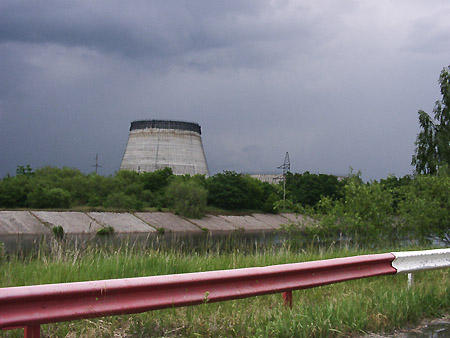

[Cooling tower and an abandoned building en route to the reactor site.]
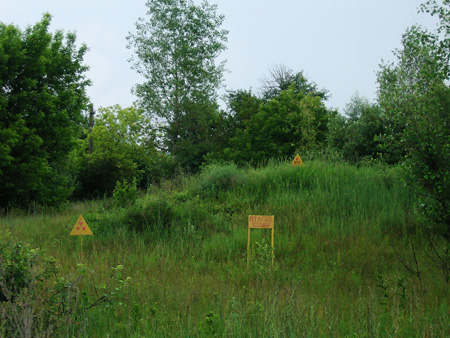
This town, called Kopachi (incidentally, on the road sign the backwards “N†symbol, which is the Russian letter for the “ee†sound, had been altered/graffitied to be an “Iâ€, the Ukrainian symbol for the same sound; just an interesting little snippet of Ukrainian nationalism it would seem) was the closest to the reactor and was severely dosed with radiation. After the inhabitants were evacuated (I read they were not evacuated until May 3rd, seven full days after the explosion), the buildings were bulldozed and buried in trenches. All that remains are a few signs poking out of grassy knolls telling you of the buried radioactive waste, or might I say destroyed homes, personal belongings, and ruined lives.
Unfortunately, burying buildings and dangerously radioactive materials did not pan out as planned. The buried materials were close to the water table and any plants and trees that grew over the mess brought radiation right back up to the surface again. There are hundreds (like, 800 or so) sites all over the zone of buried equipment, metal, buildings, personal effects, automobiles, etc. Many of the locations of these sites have been lost over time as the landscape changes. One Chernobyl biologist [from Wormwood Forest] said it was easy to spot buried waste; the leaves of the pine trees have mutated in areas of extreme radiation, like over buried waste, and so just look for patches of the mutated trees and you have found your site. Another interesting article I read told of a guy who went to Chernobyl in the mid 90s to photograph one of the sites very close to the reactor. They had an extremely difficult time finding the site, getting vague information and the runaround by all the officials and it finally occurred to them what had happened: the site no longer existed, having been looted completely for parts to sell in used-part markets or just as scrap metal.

[This is Reactor 5, which was under construction when #4 blew. Construction wasn’t actually permanently halted for a couple more years.]
Before we came to Chernobyl we had been living Kharkiv. Joshua was working with a group of Ukrainian programmers, one of whom, Slayer (his real name was Alekseii but since there were something like five Alekseiis at the office, none of them actually went by that name) was born in Pripyat, the city that housed the nuclear power plant workers. He was three when the accident occurred and was evacuated with his family. He never went back. When we told him we were going to visit the site he told us we were crazy. “Why would you want to go to Chernobyl. I don’t think this is a good idea.†Later, however, when we were in the van on our way to the Zone, Joshua got a text message from Slayer. He said he used to live on Sportivnaya street and it would be interesting if we happened to go there; maybe could we get a photo for him.
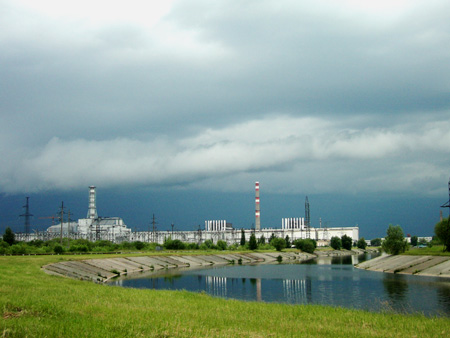
[Approaching reactors 3 and 4; they are in the same building actually, now separated by hundreds of feet of concrete.]
Our first stop was the reactor itself. There was a statue, groups of guys here and there in worker uniforms—the first indication that the Chernobyl site was far from deserted as I had previously assumed, an administrative building, and behind a chain link fence, the site of the accident itself. To me, it was hard to tell exactly what I was looking at. Not because I’m unfamiliar with soviet nuclear power plants but because the present architecture of the building is really confusing. After examining all the gray fucked-up looking parts of the reactor building, I supposed that the big boxy section was extra fucked-up looking and presumed (correctly!) that that was the Pointy End.

Directly after the accident, the site of Reactor 4 was just a smoking, gaping hole. Clean-up workers, called “liquidators,” took all the radioactive chunks they could find, chucked them in the hole (into which tons of sand, boron, clay, and lead was also dumped by helicopter), and finally a shell was constructed over the top. The “sarcophagus†was hastily erected and looks it. The roof is not bolted down from what we were told and the whole thing, while not necessarily about to fall down, isn’t exactly a bastion of strength and durability. Sunlight streams through cracks in the roof and I’ve read birds roost in the structure. Plus it leaks like a sieve, percolating rainwater down through all the mess, accelerating the decay of the building and washing dirty dirt down into the groundwater, presumably. And before that gets you all alarmed, think about how the reactor is built right on the Pripyat river, which empties into the Dnepr, which is one of the major waterways of Europe. There is absolutely no way to really contain the contamination.

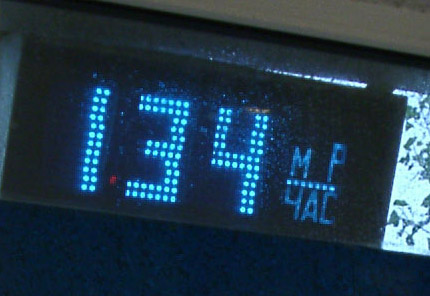
[This was the docimeter located inside the office about 200 meters from the reactor. We weren’t supposed to take photos of it for some reason; I got yelled at actually.]
We were given a crisp little lecture in a precise and carefully accented English about the plant and the accident, shown some slides and diagrams, and told a lot of Statistics and Facts. Our lecturer pronounced sarcophagus “sarko-FAY-gus†(snicker snicker; yes I’m 12) and ranted on continually about the mammoth beam (pronounced “mommouth†beam), which lies across the top of the structure supporting the roof. I guess it was significant because it is pretty much the one piece of construction of any integrity and it’s balanced atop the whole shebang under a roof that is not bolted down. Plans for a new structure are in the works, of course. Of course.
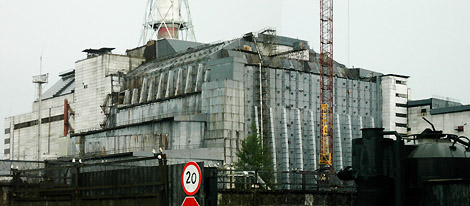
[The pointy end.]
I won’t go into details about how the reactor blew except to say it was a power-down test gone mind-numbingly awry. On April 26th, 1986, there was a steam explosion that blew the roof off the reactor and shot a bunch of radioactive particles like cesium-137 and strontium-90 into the air and exposed the reactor’s sensitive innards, a super-hot combustible graphite core, to oxygen. The burning graphite moderator belched tones of dirty particulate into the atmosphere; the reactor had no containment building (not unusual for Soviet reactors). Lessons were learned, naturally.
Numbers of dead vary tremendously. Usually you see a number around 30, which refers to the two who died in the initial steam explosion and the 28 who died soon after from lethal doses of radiation. The vast majority of those killed were firefighters and rescue workers who arrived at the scene but were not told exactly what they were going into. This number does not include those who died afterward from exposure to fallout and prolonged exposure to radioactive surroundings, contaminated foods, milk. The liquidators, the people who lived in the immediate area or downwind. Those numbers are too difficult to calculate but I read estimates in the 60,000 range. Greenpeace’s numbers of cancers directly attributable to Chernobyl are over a quarter of a million with nearly 100,000 of those being fatal. Slayer, though he seemed fine for the most part, suffered from vague and mysterious health abnormalities. “Infection†was the best word they could come up with in English, and he was frequently absent from work because of it.
After the explosion, the liquidators were hired or conscripted to help clean up the mess. There were some volunteers but the vast majority were not given a choice, those in the army or men with particular skills required for the clean-up (miners, or pilots, for example). From everything I read, very few actually understood the danger of radiation; I read over and over where men said, “of course we weren’t afraid; we simply didn’t know.” The most prolific rumor flying around the site was that vodka helped with the radiation. I think it’s safe to say that an extraordinary amount of the stuff was consumed in the months and years following the disaster.
In addition to not being briefed on the dangers of radiation, the liquidators in general were given grossly inadequate protective gear. And if they were given any protective clothing, they had no access to laundry facilities and wore the same dirty gear day after day. Only the scientists carried dosimeters; individual liquidators did not have dosimeters on their person. The government decided upon a maximum cumulative “safe” level of radiation (25 Roentgens). Once a worker hit his 25 Roentgens, he was sent home. Incidentally, the current maximum “safe” cumulative level of radiation is more around 2 Roentgens. Depending upon what job you were doing, this radiation you were exposed to varied tremendously. Most workers believe they accumulated far and above the maximum allowable dose. They ate and drank food and water from the Zone, they had inadequate protective gear or knowledge about how radiation worked. In addition, radiation levels were calculated rather arbitrarily. One pilot who flew helicopters over the reactor all day taking readings and photos of the damage said his daily dosage was calculated 10-15 kilometers away by measuring the background radiation, then multiplying it by the number of hours worked.
The official word was that only volunteers went up on the roof of the reactor but it was generally understood among the army men that you would be jailed for insubordination (for years) if you did not go. Those working clean-up at the reactor were officially allowed to work only 45 seconds per day lest they overshoot their daily radiation quota (2.5 Roentgens). An interview I read with one of the liquidators said they generally worked from 45 seconds to 3 minutes depending upon how hot the area was at the moment. Other liquidators said people were working full days up on the roof of the reactor, shoveling graphite and debris. Supposedly they tried at first to use robots to move the really dirty stuff but the radioactivity fried the wiring. The majority of the clean-up was done by 1989 by some 900,000 liquidators in all.

[The monument to the liquidators in the town of Chornobyl.]
A quick bit on radiation levels. They are measured in Roentgens per hour (R/h) or micro-Roentgens/hour (mR/h), which is a thousandth of a Roentgen. Normal background radiation levels in a normal city are in the ballpark of 10-50 mR/h and a typical yearly dosage is around 200 mR. 500 Roentgens over a period of five hours would be lethal for a human. Of the major reactive isotopes ejected by the reactor, Iodine-131 is very radioactive but short lived (8-day half life). Later the danger was cesium-137 (30-year half life) and strontium-90 (29 years). The entire Zone reads like a “cheetah skin†in the words of one liquidator, with patches of super hot and areas of not so hot. The only way to be sure is to carry a dosimeter on you at all times. Awesomely, when we visited all dosimeters were on the fritz, aside from the one inside the office adjacent to Reactor 4, and we just had to take the guide’s word for it, stay off the moss, not snack on any stray mushrooms, etc.
Pripyat, the city of 50,000 that housed the plant workers, was evacuated 36 hours after the accident. It is one of the tragedies of the accident that it took so long for the government to give the order to evacuate. A full day and a half of mild spring weather where people were only told there was a fire at the reactor and no big whoop. Windows were open, people were out enjoying the day, and in an effort to avoid creating a panic, people were encouraged to go about their business. People gathered on rooftops and the so-called “Bridge of Death†to watch the pretty glowing lights coming from the burning graphite core; here they received a dose of radiation in excess of 500 Roentgens/hour. May 2-7th, everyone within a 30 km radius was evacuated (~4300 square kilometers), some 210,000 in all. Quite a number of these people have returned, older people for whom living in some dingy bloc high rise on a meager pension was far more traumatic than scraping out a living in the only home they have ever known, even if it is from a poisoned earth surrounded by radioactive animals. To the majority of these people, radiation is hard if not impossible to comprehend. It is invisible, it is complicated, and the whole thing probably smacked of yet another line of government bullshit. They were told the soil was deadly toxic, yet tomatoes still grew, flowers still bloomed. When we were there, we were told that there were between 200 and 300 elderly people living within the 30-kilometer perimeter (nobody lived within the 10-kilometer perimeter; it was not even allowed to be there after dark); for the most part, they didn’t have very many years left in them anyway. The authorities pretty much just turn a blind eye to them and even provide limited aid. You see horse-drawn carts periodically, wrinkled toothless old men at the helm.
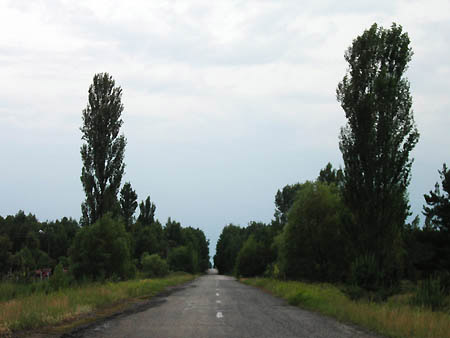
It took years after the incident for information about the disaster to be released. Even today people’s perception of the danger and effects of the accident are hazy and rife with misinformation if not outright superstition. We heard things like, “My niece was sitting in school next to an open south-facing window in Moscow the day the reactor blew and she has cancer now. I’m sure it is because of the exposure.” Another we talked to said that she was a young girl living in Kiev during the explosion. Nobody in the city knew what was going on, just that there was an accident at Chernobyl. Utter chaos ensued; people were trying desperately to get out of town, trains were booked solid and packed with hysterical people. The only source of accurate information was coming from radio abroad and the government was doing its best to jam the frequencies. It was days after May Day before Gorbechev came on the TV and said everything was cool, no need to panic, that there was no danger, and the situation was under control. It was pretty much a propaganda extravaganza.
Our perception of the Ukrainians’ feelings about the accident (as filtered primarily through Rimma but also from a few others we spoke with) was that of mistrust and an enormous betrayal by their government, which is to say, the soviet government, which is to say, Russia now. Rimma spoke evenly and factually but the vehemence in her voice was unmistakable. The fact that the government kept the accident a secret is unforgivable. Firefighters were not told what they were dealing with, the Pripyat was not evacuated immediately or at the very least told to stay indoors. The government only admitted there was an accident after some nuclear power plant workers in SWEDEN were dusted with radioactive particles and as they came off shift, alarms went off. Once they had determined that there was no radiation leak at the Swedish plant, they began to trace the radioactivity. Maps of the radiation distribution show that except for Spain and Portugal, nearly all of Europe was covered with fallout.
Another thing that I was truly surprised to learn is that the plant did not shut down after the accident. Due to energy demands, they couldn’t just power down and close the plant. The Ukrainian plant also supplied power that was purchased by other countries in Europe; it was not in the government’s interest to shut it down. There were four reactors, three still technically in full working order. Reactors 1 and 2 were each located in their own building; reactors 3 and 4 were in the same building sharing a vent (smokestack). It wasn’t until 2000 when international pressure from abroad finally convinced the Ukrainian government to shut down the last reactor for good. Reactor 2 was shut down in 1991 after a fire, Reactor 1 in 1997, and Reactor 3 (in the same building as the one that blew) in 2000. So of course this means there were a large number of power plant workers working in all of these reactors until 2000. Even with all reactors out of commission, they still contain fuel so constant monitoring and maintenance are required. In addition, the delicate state of Reactor 4 and indeed the entire plant is considered a security risk. There are just a lot of people there; it’s hardly deserted.



April 29th, 2009 at 5:44 pm
very fascinating…always wanted to visit the site.
Thanks for the info.
April 30th, 2009 at 5:55 am
Very interesting! Looking forward to read the rest, during the quick breakfast before we head off to the boatyard.
May 2nd, 2009 at 4:12 pm
Geezum! That’s only part one?
Really interesting.
It rained all over Europe the week after Chernobyl and the raincloud came right over Ireland and it pissed it down for days (this is really unusual — the prevailing winds usually blow everything the other way). People were really worried, but the Irish government calmed everyone down. ‘Don’t worry’, they said, ‘only one sheep and one cabbage have tested positive for radiation’.
Years later, they admitted they’d only tested one sheep and one cabbage.
May 3rd, 2009 at 10:57 am
The soviet govt. seeded clouds over Belorus because they were worried the rainclouds would make it to Moscow before the rain fell. The Belorus are still pretty pissed about that.
Yeah, there is a lot more, particularly photos of Pripyat (we took a million of them but I had to do some serious weeding and fixing because it was a rainy dark day we were there and our cameras were old and not very good w/dark). We’re in AZ visiting but I’ll try to get the next segment up when we get back.
May 7th, 2009 at 2:59 pm
Thank you for taking the time to make this post. I had vague memories of when it happened (I was 24 in in the US) but never knew of any detail. I had no idea what the area was like now. Your article was so interesting that I went to Wikipedia to read more and now understand better what happened. I also happened across this very interesting website of a woman who rides her motorcycle in the area now. Many moving photographs and I like the perspective of a “local” (yet her dad is a nuclear physicist so she understands the science of it completely).
http://www.kiddofspeed.com/chapter1.html
I’m looking forward to reading your Part II
Thanks again,
R.
May 7th, 2009 at 6:23 pm
Interestingly, Elena’s story is only partly true. She and her husband went on the tour a couple of times and brought a motorcycle helmet and jacket. During the tour, Elena would put on the jacket and hold the helmet while her husband took photos. The guides thought this odd behavior but soon figured out what they were doing once the photo essay went online. She didn’t enter the exclusion zone with a motorcycle although obviously from her photos, she did some riding near the zone (the photos of her and the bike are all along the way to the site but there aren’t any photos of the bike within the zone). Rimma said her husband wrote the thing anyway (whether this is true, I don’t know). Nonetheless, the photoessay is totally interesting and full of photos; it in part sparked our interest in the site and gave us the idea to go visit.
I’ll try to get part II up soon; I’ve been out of town the past several days so I haven’t had a chance to do any work on it at all but I’m back now.
May 8th, 2009 at 12:33 am
That is interesting. I noticed that many of the photos showed her back or shoulder (with the leather jacket and bag) in the foreground. Even though she indicated that she occasionally took a passenger along, it seemed odd/funny that she’d have that person taking the photos so often and from that perspective. As you say, still compelling images.
May 12th, 2009 at 7:48 am
http://www.guardian.co.uk/environment/2009/may/12/farmers-restricted-chernobyl-disaster
July 31st, 2010 at 1:16 pm
I have enjoyed your posts about Chernobyl several times and each time I read them, it sparks an interests in traveling there. Thanks for sharing your adventure!
August 25th, 2010 at 8:32 am
thay were telling about 7,000,000 lives lost. to bad the ministery of power did not pay it bill. the more thay ecslued me the higher the casulity rate.
no cash: not technologys. THe pharmasuteals were ready. US DOD cheack bounst.
June 6th, 2011 at 12:20 pm
[…] […]
July 29th, 2012 at 2:41 pm
Thank you very much for this work. It is very well compiled and structurely very well set up. I was a youngster on the 26th of April 1986 and I have ever been able to get it out of my mind. Not a week passes that I don’t look through the net for more information. I have read lots of offical reports and other peoples work.
Again, thank you very much
October 26th, 2013 at 5:59 am
very well, that’s intresting
February 13th, 2022 at 10:33 am
Just wanted to send a thank you from me to you in this year 2022 for your writings on Chernobyl. This is a very intriguing subject. I myself would like to visit Chernobyl after college. I feel that one day soon Pripyat will be demolished by local government. May this piece of work of yours live on for others to see and admire.